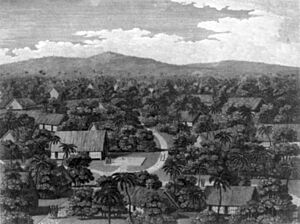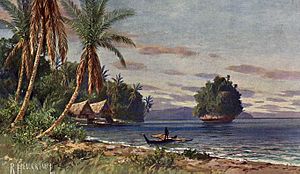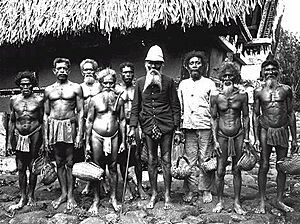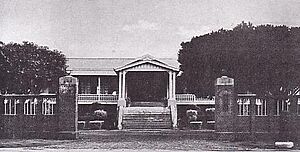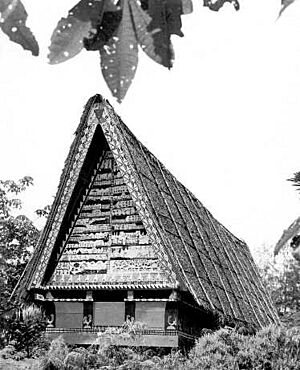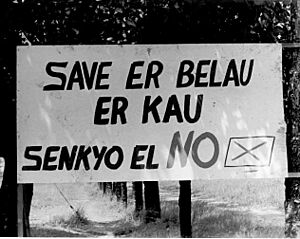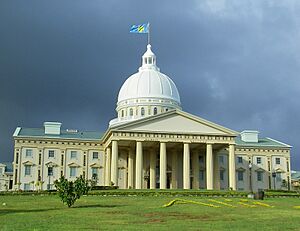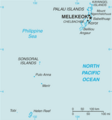History of Palau facts for kids
Palau is a beautiful island nation in the Pacific Ocean. People first settled here around 1000 BC.
Europeans might have seen Palau as early as 1522 during Ferdinand Magellan's famous trip around the world. However, the islands were truly discovered by Europeans on December 28, 1696. This happened when a group of Palauans were shipwrecked in the Philippines. A Czech missionary named Paul Klein talked to them. He drew the first map of Palau based on their descriptions! This map made many people in Europe interested in Palau.
Later, in 1710, a Jesuit group visited the islands. After more attempts, Palau became part of the Spanish East Indies in 1885. Spain then sold the islands to Imperial Germany in 1899. During World War I, Japan took control. In World War II, the United States took the islands in 1944 after a very tough battle called the Battle of Peleliu. Thousands of American and Japanese soldiers died there.
After the war, Palau became part of a Trust Territory managed by the United States. In 1979, some districts formed a new country called Micronesia, but Palau decided to become independent. Palau approved its own constitution in 1981 and became the Republic of Palau. It signed a special agreement with the United States in 1982. After many votes, Palau officially became independent on October 1, 1994.
In 1998, Palau passed laws to become a financial center. By 2001, it had laws to control banks and prevent illegal money activities.
Contents
Early History of Palau
Scientists have found evidence of people living in Palau for a very long time. Carbon dating of bones found in caves shows that a small group of people, sometimes called "pygmies," lived here from about 4,500 years ago until about 900 years ago. This might have happened because living on small islands can make animals (and sometimes people) grow smaller over many generations.
The oldest clear signs of people living in Palau come from around the 1st and 2nd centuries AD. These signs include old shell piles, called middens, found on Kayangel island. Other findings show that people built large terraces on the volcanic islands. These terraces were likely used for farming or living.
Around the year 1100 AD, people started building more terraces and living in larger, more organized villages on the rock islands. However, many of these villages were suddenly left empty in the early 1400s. By the 16th century, the way villages were set up, with special stone features and community areas, was similar to what we see in Palau today.
Palauan Culture Before Europeans Arrived
The Palauan language is quite unique compared to other languages in the Pacific. Some experts think it might have come from the Sunda Islands (which are now part of Indonesia).
People first migrated to Palau and settled the islands around 2,000 years ago. By 600 AD, there were settlements all over the islands.
For thousands of years, Palauans have had a special way of organizing their society called a matrilineal society. This means that important things like land, money, and titles are passed down through the mother's family line. High Chiefs were chosen by high-ranking women. Even today, clan lands are passed through women. However, during the time Japan ruled Palau, they tried to change this system.
European Contact and Discovery
Historians still discuss whether early European explorers saw Palau in the 1500s. Some think the Spanish explorer Ruy López de Villalobos might have seen the southernmost islands in 1543, but there is no clear proof.
The first definite discovery of Palau by Europeans happened in December 1696. This was when a group of Palauans were shipwrecked in the Philippines. A Czech missionary named Paul Klein talked to them. He drew the first map of Palau based on their descriptions and sent a letter to Europe in 1697. This sparked a lot of interest in the islands.
The first European visit to Palau was by a Jesuit group led by Francisco Padilla on November 30, 1710. They accidentally left two priests stranded on Sonsorol island during a storm. Later, Spain began to control the islands.
Before the 1700s, Palau had limited contact with the outside world, mostly with nearby islands like Yap and Java. If those shipwrecked islanders hadn't reached the Philippines in 1696, Europeans might not have found Palau until much later.
In 1783, an Englishman named Henry Wilson, captain of the ship Antelope, was shipwrecked near Ulong island. The High Chief of Koror, Abba Thulle, allowed Captain Wilson to take his son, Prince Lee Boo, to England. Prince Lee Boo arrived in England in 1784 but sadly died soon after from smallpox. Captain Wilson was the one who gave the islands the name "Pelew Islands." This shipwreck marked the beginning of European involvement in Palau.
Spanish Rule in Palau
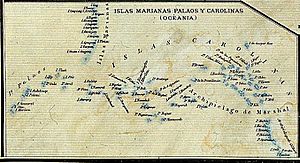
In the late 1800s, Britain, Spain, and Imperial Germany all claimed Palau. In 1885, Pope Leo XIII was asked to decide. The Pope said Spain owned the islands but allowed Britain and Germany to have economic rights. Palau then became part of the Spanish East Indies, which included the Mariana Islands, Marshall Islands, and other Caroline Islands. They were all managed from the Philippines.
Spain gained control in 1885. They didn't do much to develop the islands, but they did set up Catholic missions in Koror and Melekeok. After losing the Spanish–American War in 1898, Spain sold Palau to Imperial Germany in 1899.
German Era in Palau
When Germany bought Palau from Spain in 1899, a period of economic growth began. Palau was managed from German New Guinea. German engineers started mining for valuable minerals like bauxite and phosphate. They also harvested a lot of copra, which is dried coconut meat.
The German government started several mining companies and coconut plantations. They also made social changes, like moving people into larger villages and building public projects such as piers and navigation lights. Young men were sometimes forced to work in the mines or on plantations.
Japanese Mandate in Palau

During World War I, Japan declared war on Germany and took control of Germany's islands in the Pacific, including Palau. After the war, the League of Nations gave Palau to Japan to manage. This was called a "mandate."
The Japanese government wanted to make Micronesia, including Palau, an extension of Japanese culture and economy. Many Japanese and Ryukyuans (people from islands south of Japan) were encouraged to move to Palau to work. By 1938, there were about 15,000 Japanese people in Palau, compared to only about 6,000 Palauans. Koror became a big Japanese city.
Japan made Palau an important part of its empire. They set up a government in Koror. Japan started a strong economic development plan. They continued the German mining activities and also built factories for canning bonito (a type of tuna) and processing copra.
Japanese trading companies quickly started businesses to use the islands' resources, especially fish and pearls. They built a business center in Koror and started farms on Babeldaob Island. The Japanese also brought modern water and electricity systems and built primary schools for Palauans. Many older Palauans remember the Japanese time as orderly and efficient. However, native Palauans were often treated as second-class citizens and used as cheap labor.
Palau During World War II
Life was very difficult for Palauans during World War II. By the late 1930s, Japan was building up its military, and restrictions were placed on Palauans. As the war turned against Japan in 1942, these restrictions increased, and food became scarce. Palauans were forced to work on building island defenses. Many Palauans were moved from larger towns to villages on Babeldaob Island, where they were expected to grow more food for the Japanese soldiers.
In 1944, American forces attacked the islands of Beliliou and Angaur in a very fierce and bloody battle. The Japanese had built strong defenses using the natural caves and tunnels in the limestone. They had bunkers and hidden gun positions where over 10,000 soldiers could hide from naval attacks. When the Americans landed, they faced heavy gunfire. It took more than 66 days and cost many American lives to take the island. Each Japanese position had to be captured one by one. After this terrible battle, American military leaders decided to bypass the 30,000 Japanese troops still on Koror and Babeldaob. Instead, planes from Beliliou and Angaur bombed and attacked the northern islands daily.
The last months of the war were grim. American planes flew overhead, bombing targets. The large number of Japanese soldiers ran out of food and became desperate. Palauans remember the fear of air attacks and Japanese soldiers taking their already limited food supplies. Many people suffered from starvation and disease before the Japanese forces surrendered.
At the end of the war, fewer than five thousand Palauans were left alive. All surviving Japanese soldiers were sent back to Japan. There are still about 100 American servicemen missing in Palau. Since 1993, a group of American volunteers called The BentProp Project has searched Palau's waters and jungles to find information that could help identify and recover these missing soldiers. The Palauan people have allowed both the Japanese and US governments to search for their missing soldiers, showing their hospitality.
Palau After the War
In 1947, the United States agreed to manage Palau as part of the Trust Territory of the Pacific Islands (TTPI), created by the United Nations. In the 1960s and 1970s, the U.S. started many programs to help Palau, improving transportation, water, and sewage systems.
After many years of discussions about Palau's future, the U.S. Congress approved a special agreement called the Compact of Free Association in 1986. This agreement was supported by most Palauan voters in several votes. However, Palau's constitution required a 75% majority for issues that might involve nuclear matters, and this was hard to reach. After a change to the constitution and a long period of transition, Palau's courts decided that a 68% vote in favor of the compact in 1993 was enough.
On October 1, 1994, Palau officially became an independent nation, in free association with the U.S. Under this agreement, the U.S. is responsible for Palau's defense for 50 years. The U.S. must approve any foreign military entering Palau and can set up military bases there. Palau also receives financial help from the U.S. and can join some U.S. federal programs. It is estimated that this help will be worth over $500 million.
In November 2020, Surangel Whipps Jr. was elected as the new President of Palau, taking over from President Tommy Remengesau.
Images for kids
-
Republic of Palau
See also
 In Spanish: Historia de Palaos para niños
In Spanish: Historia de Palaos para niños
- Imeong Conservation Area


